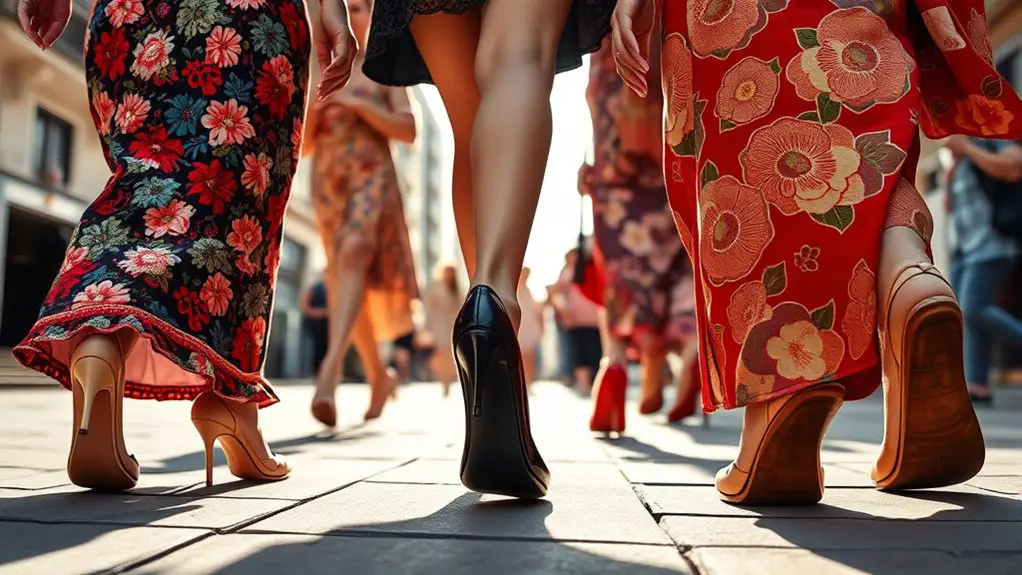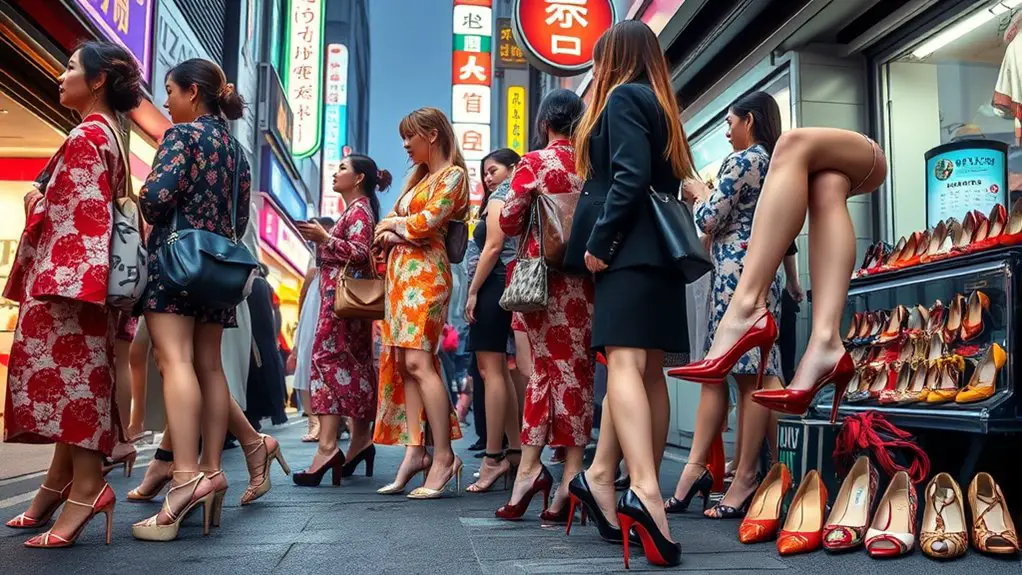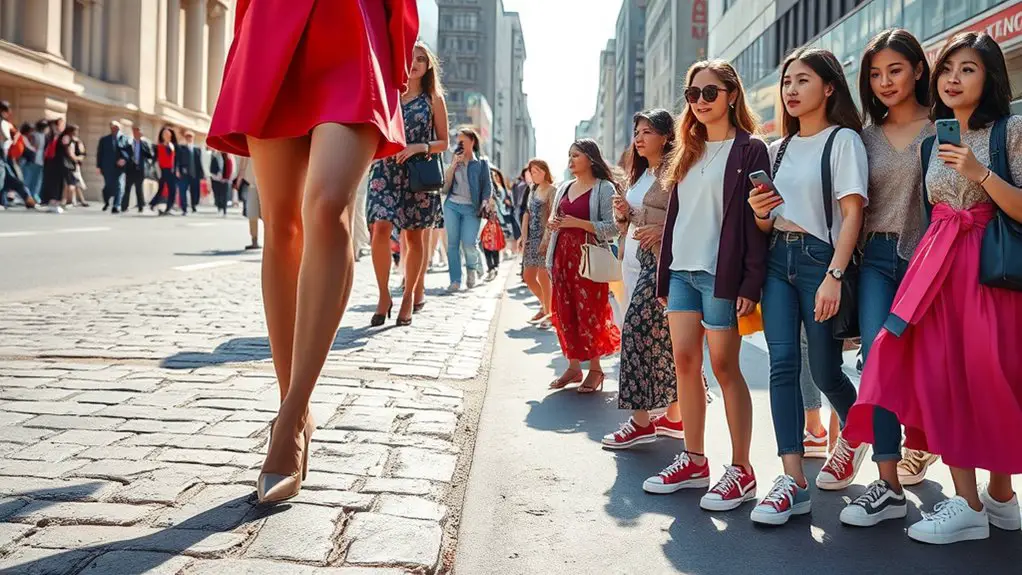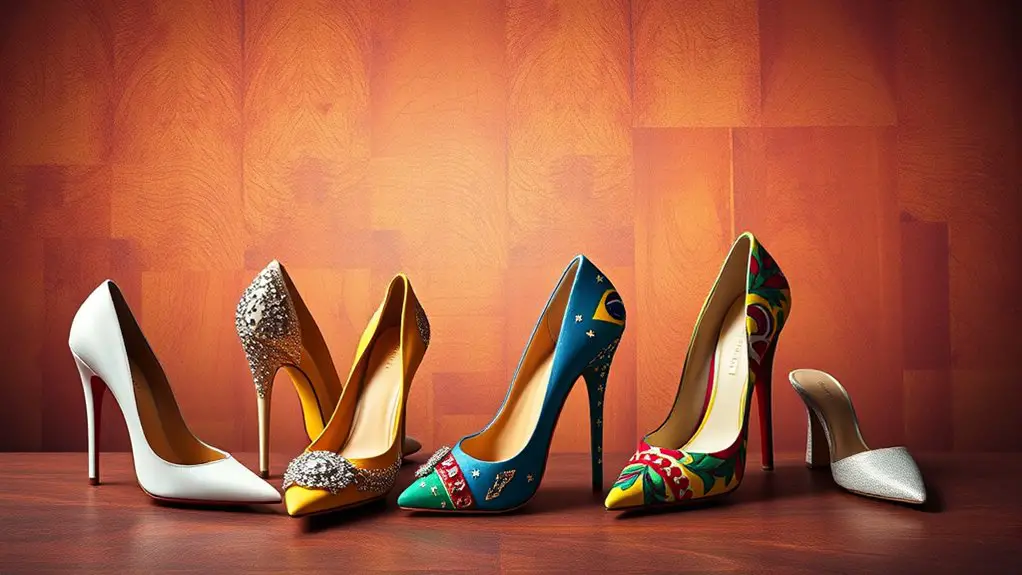Different countries view high heels through unique cultural lenses. In Western fashion, they symbolize empowerment and confidence, while in many Asian cultures, they often reflect traditional femininity and grace. In the Middle East, high heels can blend tradition with modernity, expressing personal style. However, the global push towards comfortable footwear is reshaping perceptions, challenging traditional norms. If you’re curious about how these trends shape individual identity and societal expectations, there’s much more to uncover.
The Historical Significance of High Heels

Although you might think of high heels as a modern fashion statement, their historical significance dates back centuries, intertwining with social status and gender roles. The historical origins of high heels can be traced to the 10th century, where Persian cavalrymen wore them to secure their boots in stirrups. By the 16th century, high heels made their way into European courts, heavily influenced by royalty. Remarkably, King Louis XIV of France famously donned red-soled heels, symbolizing his power and status.
As high heels evolved, they became associated with femininity, with women adopting them to signify elegance and class. This royal influence shaped societal perceptions, embedding high heels deeply in the fashion hierarchy. Consequently, when you slip into a pair, remember that they’re not merely a choice of style; they’re a reflection of a rich historical narrative tied to empowerment, prestige, and gender dynamics.
High Heels in Western Fashion: A Symbol of Empowerment
Empowerment often takes on many forms, and in Western fashion, high heels have emerged as a powerful symbol of confidence and independence. For many, slipping into a pair of heels transforms not just your height, but your entire demeanor. This empowerment narrative is deeply rooted in societal perceptions, where high heels are often associated with professionalism and assertiveness. When you wear them, you might experience a noticeable confidence boost, feeling more poised and ready to tackle challenges.
However, it’s important to recognize that this empowerment can be complex. While heels can elevate your stature, they also come with discomfort and societal pressures. Ultimately, the choice to wear high heels reflects personal empowerment, allowing you to express your identity and style. In Western fashion, they represent more than just a trend; they embody the ongoing dialogue about femininity, strength, and self-expression.
Cultural Attitudes Towards High Heels in Asia

In many Asian cultures, high heels are often seen as a traditional symbol of femininity, reflecting ideals of grace and elegance. However, as fashion trends evolve, these shoes are also embraced as stylish footwear that complements modern attire. You’ll find that this duality showcases the complex relationship between cultural heritage and contemporary fashion in the region.
Traditional Symbol of Femininity
While high heels are often celebrated for their aesthetic appeal, their cultural significance in Asia runs deeper, intertwining with traditional views of femininity. For many, wearing high heels symbolizes a woman’s feminine identity, aligning with societal expectations that emphasize grace and poise.
Here are some key aspects of this relationship:
- Cultural Heritage: High heels are often seen as a continuation of traditional values regarding femininity.
- Status Symbol: In some societies, they signify wealth and social standing.
- Professional Image: Many women wear heels to project authority and confidence in the workplace.
- Rituals and Celebrations: Heels are often integral to traditional attire during important events, reinforcing their symbolic role.
These factors contribute to the complex narrative surrounding high heels in Asian culture.
Fashionable Footwear Trends
As fashion evolves, so do the cultural attitudes towards high heels in Asia, reflecting a blend of tradition and modernity. Today, you’ll see a shift towards sustainable materials and eco-friendly practices, with brands investing in designer collaborations that emphasize both style and responsibility. Vintage styles are making a comeback, often infused with contemporary street style, offering unique looks that resonate with younger generations. Seasonal trends also dictate color palettes, with soft pastels in spring and bold hues in winter capturing attention. Celebrity influences play a significant role in shaping preferences and fostering brand loyalty, as fans emulate their favorite stars. In this dynamic landscape, high heels are not just footwear; they’re a statement of identity and cultural evolution.
The Role of High Heels in Middle Eastern Fashion
In the Middle East, high heels play a significant role in expressing cultural identity and personal style. You’ll find that these shoes often blend traditional modesty with contemporary fashion trends, reflecting a unique balance between heritage and modernity. As you explore this topic, consider how high heels influence social perceptions and the evolving landscape of Middle Eastern fashion.
Cultural Significance of Heels
High heels hold a unique place in Middle Eastern fashion, serving not just as a style statement but also as a symbol of cultural identity and empowerment. They reflect the historic evolution of fashion within the region and challenge societal expectations surrounding gender expression. Here are four key aspects of their cultural significance:
- Cultural Symbolism: Heels often represent femininity and strength, intertwining identity with aesthetic value.
- Fashion Identity: They play an essential role in shaping how women express their personal style.
- Body Image: High heels can enhance perceived body proportions, affecting confidence levels.
- Cross-Cultural Differences: Attitudes toward heels vary, showcasing the complexities of fashion in different Middle Eastern societies.
Through these lenses, high heels become more than just footwear; they embody a rich tapestry of meaning.
Fashion Trends and Influences
While many people may view high heels as mere fashion accessories, their role in Middle Eastern fashion is far more complex and influential. You’ll find high heels at the intersection of tradition and modernity, shaped by fashion influencers who draw from global styles. Designer collaborations often result in stunning seasonal collections that reflect both local culture and international trends. High heels dominate runway trends, showcasing their power in the fashion hierarchy. Additionally, street fashion embraces them, blending elegance with everyday wear. The celebrity impact is undeniable, as stars showcase high heels that inspire countless fans. Retail strategies are also evolving, focusing on these iconic shoes to attract a diverse clientele, making high heels a staple in Middle Eastern wardrobes.
High Heels and Modesty
Although many perceive high heels as symbols of empowerment and style, their significance in Middle Eastern fashion often intertwines with cultural notions of modesty. In this region, high heels can reflect a complex relationship with modesty standards and cultural perceptions. Here are a few key points to evaluate:
- Elegance: High heels can enhance traditional attire, adding a touch of sophistication.
- Cultural Events: They’re often reserved for special occasions, reinforcing social norms.
- Confidence: Wearing heels may empower women, allowing them to navigate societal expectations.
- Fashion Statements: High heels serve as a way to express individuality while adhering to modesty guidelines.
In this context, high heels aren’t just footwear; they’re a balancing act between style and tradition.
High Heels and Gender Norms: A Global Perspective
As you explore the world of fashion, it becomes clear that high heels have evolved into potent symbols of gender norms across different cultures. These stylish accessories often reflect social expectations tied to gender expression and body image. In many societies, wearing heels can be seen as a fashion statement that aligns with cultural symbolism of femininity and power dynamics. For women, high heels in professional attire may convey authority, yet they can also be scrutinized through a feminist critique, highlighting the pressures of conforming to these ideals. While some embrace heels as a part of their personal identity, others challenge the notion that they must endure discomfort for societal acceptance. This duality raises questions about gender equality and the often unspoken expectations surrounding footwear. Ultimately, high heels encapsulate a complex relationship between fashion, empowerment, and the ongoing dialogue about gender norms worldwide.
The Shift Towards Comfort: Casual Footwear Trends

With the increasing prioritization of comfort in daily life, casual footwear trends are rapidly altering the landscape of fashion. You might notice that styles are shifting towards practicality, making it easier to blend comfort with aesthetic appeal. Here are some key trends to reflect upon:
- Comfortable sneakers – Perfect for everyday wear, they’re not only stylish but also provide support.
- Casual loafers – These slip-on styles offer a polished look while ensuring ease and flexibility.
- Athleisure footwear – Combining athletic functionality with casual style, they fit seamlessly into your active lifestyle.
- Versatile flats – Minimalist designs made from sustainable materials can change effortlessly from work to play.
This shift not only reflects a desire for everyday practicality but also embraces a more sustainable approach to fashion. Embracing these trends allows you to prioritize comfort without sacrificing style.
The Future of High Heels in Fashion and Society
While many fashion enthusiasts celebrate the elegance of high heels, their future in both fashion and society is increasingly complex. As you look ahead, you’ll notice a shift toward sustainability, with designers opting for sustainable materials that reduce environmental impact. This trend not only addresses climate concerns but also reflects a growing demand for responsible fashion choices.
Moreover, digital fashion is reshaping how we perceive high heels. Virtual fittings and digital wardrobes allow you to explore styles without the physical constraints of traditional footwear. Imagine strutting in a pair of stunning digital heels that exist only in the virtual world, sparking creativity and self-expression.
As societal norms evolve, the role of high heels may transform, prioritizing comfort without sacrificing style. The future of high heels could blend elegance with sustainability, making it an exciting time for fashion enthusiasts like you to embrace change and innovation.
Frequently Asked Questions
How Do High Heels Affect Posture and Health?
If you wear high heels regularly, like many professionals, you might notice a shift in your posture. This can lead to health concerns, including back pain and ankle instability, as your body adjusts to the altered alignment.
Are There Any Famous High Heel Designers?
When you think of famous designers in high heels, names like Christian Louboutin and Manolo Blahnik come to mind. These iconic brands have shaped fashion with their unique styles, blending elegance and bold creativity in every pair.
What Are the Most Popular High Heel Styles Worldwide?
When it comes to high heels, think of them as fashion’s skyscrapers—towering and bold. Trending styles like stilettos and block heels carry cultural significance, reflecting elegance and confidence across the globe, adapting to diverse tastes and traditions.
How Do High Heels Influence Body Image Perceptions?
High heels can greatly impact your body confidence, often enhancing perceived elegance and stature. Their cultural significance varies, shaping how you and others view femininity and attractiveness, influencing personal and societal body image perceptions.
What Materials Are Commonly Used in High Heel Production?
Imagine slipping into a pair of stunning leather heels, their heights elevating not just your stature but your confidence. Common materials include various leather types, influencing both comfort and style in high heel production.



